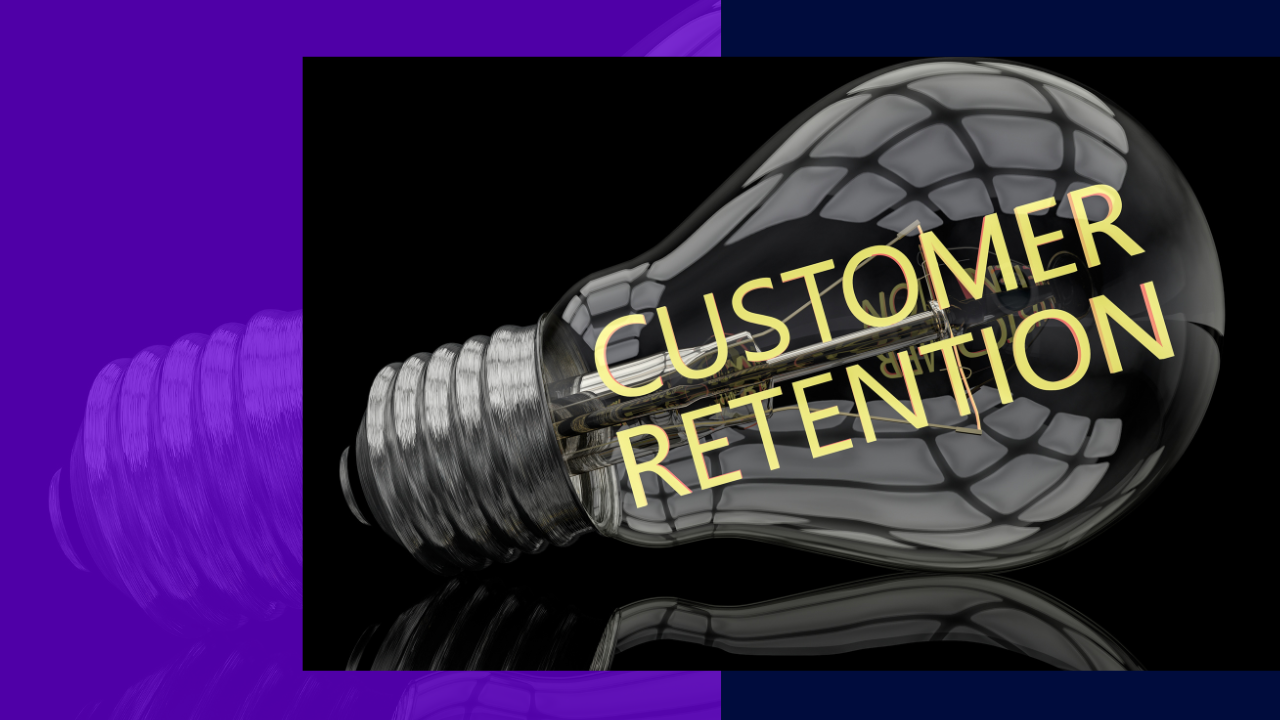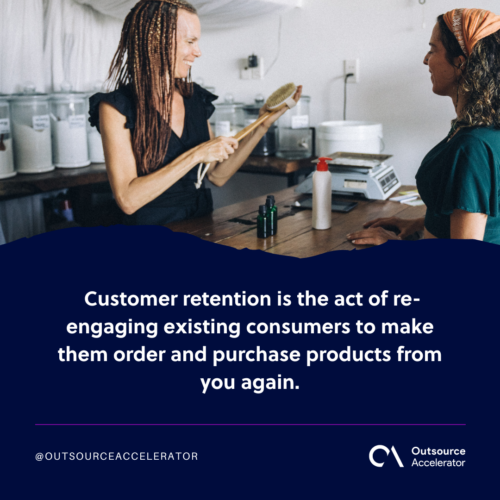Customer retention: The whys and the hows

In today’s market where similar companies are vying for the attention of consumers, it’s hard to be unique in a sense. There will always be someone who did this campaign first, someone who got to the top of the trend before you did.
The next best thing you could do is to retain your existing customers while building up your new prospect list. By doing so, you’ll still be able to pull up sales and conversions.
A study from Outbound Engine showed that you’re 60-70% more likely to convert existing customers than to acquire new ones.
Customer retention can be tricky but when done right, it will be the next best thing for your business.
Customer retention definition
By definition, customer retention is the act of re-engaging existing consumers to make them order and purchase products from you again.
There are a lot of tactics that fly under the radar, especially for untrained eyes. Take Netflix’s re-engagement emails, for instance. In this situation, the company sends out emails to their existing customers that didn’t renew their subscriptions.
The email is composed of the shows and movies they watched and enjoyed, hoping to spark enough interest to rejoin the streaming site.
The best retention strategies will allow companies, just like Infinit-O, to forge long-lasting relationships with customers. Clients will likely stay loyal if they are given excellent service. When done right, customer retention can pave the way for more business for your company.
Why customer retention is important
It’s just as important as after-sales care, connecting with your existing customers is so much more cost-effective than acquiring new ones. This is because you’ve already established mutual trust and recognition with the customer.
By letting them know how successful their first few purchases are, you’re most likely to get repeat customers.
According to Harvard Business Review, customer retention just makes sense—no matter what niche or industry you’re in. It’s easier to convert known clients, as they already have a history with your business and your products.
The data shows that it’s just as important to retain customers, as to acquire new ones.
Customer retention strategies
Some customer retention strategies are subtle, some are a bit more unique, and some are carefully tailored to their best and most loyal customers. These tactics are used by most businesses who want to re-engage their audiences.
Types
On the other hand, some companies like to mix and match strategies, often to know which ones work out the best. For example, the good old rewards and points system paired up with coupons is a surefire way to keep customers on your door.
By legal contract
Usually used by corporations who hold onto their consumers via legal bonds. Telecom companies, internet service providers, and banks all have legally binding contracts that ensure that their client stays.
By circumstance
This means that the organization has monopolized the industry or has become the largest supplier of the product or service in the area. This strategy is used by utility agencies such as electrical and water companies.
By dependency
Most utilized by SaaS companies and subscription-based services, this customer retention tactic makes their consumer dependent on their products and services. Programs such as the Adobe Suite come immediately to mind.
By extra fees
There are some subscription-based services platforms that will charge their customers more if they so choose to go to the competition.
By emotional connection
A very strong customer retention ploy that bases on mutual trust and benefits that both the company and the consumer shared.
Long-term retention strategies
To be successful, you have to always plan for the future. See the big picture today so you could plan your long-term strategy for customer retention.
As always, the market will shift and the trends will falter along with your consumer engagement. Business owners like yourself can’t possibly go day-to-day just monitoring engagement rates, you have to have a game plan set for the future.
Via corporate handouts
Exclusive celebratory gift bags, vouchers, complimentary services are all part of the customer retention strategy. Companies give these out to their most loyal customers—the ones that hadn’t tried to terminate their contracts and the ones who frequent the business.
This type of retention strategy also plays up to the psychological fact that most of us want to be in an exclusive membership club, even if it’s just a decorative corporate mug. Of course, on the other side of things, this is a tactic to thank all of their existing customers for their brand loyalty.
In turn, these consumers become brand ambassadors (not to the extent of influencers, mind you), getting the word out.
Via regular communication
As a customer, have you ever got an email from a company you used to order from? This is their way to re-engage you, an existing customer, to order from them again.
Most—if not all—businesses utilize their email subscription service to reach out to their customers. The emails, by chance, often have vouchers and discount codes that you can use on a limited date. This brings up the sense of urgency, which in turn will make you consider using their platform again.
Another way is to follow up with a survey, maybe through a call or sent through a registered email. Now with surveys, the companies will get your insight as an existing consumer – and insights are the best thing for their sales and marketing department.
Via empathy
If you’ve ever given your professional contact details to partners and vendors, most of the time, they will send a corporate gift to thank you for your business. This can also be used to get in touch with you again.
Gifts, whether personal or for business, are often welcomed with sincerity and this opens up so many opportunities for customer retention to take root. For instance, as a consumer who received a gift, you will most likely think about the business that gave you a handout.
This means that you’re more likely to do business with them again and be a loyal customer.

How to measure customer retention
To know whether your tactics are successful, you need to measure and monitor your retention rate. This is to say that you need solid information, the one than can be backed by math and data.
A basic customer retention equation can be used to assess a company’s retention rate:
Retention rate = ((CE-CN)/CS))100
CE represents the total number of consumers at the end of the term.
The number of new consumers gained during the period is represented by the letter CN.
CS stands for the total number of consumers at the start of the period.
For instance, if you start with 200 customers and lose 20 while gaining 40, you will end up with 220 customers at the end of the time.
180/200 = 0.9, and 0.9 x 100 = 90. 220-40 = 180, 180/200 = 0.9, and 0.9 x 100 = 90. For the time frame under this, the retention rate was 90%.
Tracking retention rates allow businesses to bring their customer retention rates into context and monitor results over time.
Customer retention rate definition
The customer retention rate is the percentage of which the company regains its consumers over a period of time. The time frame can range anywhere from a month, a quarter, or to a year. Experts believe that retention rates are most accurate when they are measured over a regulated term.
The retention, of course, comes with consumers that want absolutely nothing anymore. No amount of re-engagement emails and phone calls will ever get them to do business with a brand again.
As a business owner, you have to monitor these parameters as well, adding them to the datasheet of your audience. Thus, the term customer churn rate is introduced.
Customer churn rate
The churn rate is the term used to describe when customers cut off their business from an entity. Somewhat similar to employee turnover rate, this is used to monitor consumers who stopped buying and interacting with a company’s product or service.
Improving your customer retention strategies
The customer journey map
In order to be more efficient in tracking your consumer movement, there is a thought map for that. It’s called the customer journey map. It’s basically a simple, pretty straightforward, laid-out device to help you understand why some consumers never return to your business.
The map is highlighted by three stages: awareness, consideration, and decision. Given that you already have the pertinent information about your audience’s demographic, identifying them into these parts shouldn’t be too difficult.
At this point, you already should have at least a couple of questions in the back of your mind. How will the customers find out about my product and will they be interacting with my marketing tactics? These questions are a great starting off point for when you come up with campaigns and events.
To sum it all up, the customer journey map will help you round out your marketing strategies and understand the market a little bit better. It’ll help you navigate your audience, creating a productive environment for them.
Rounding out, customer retention is an important aspect of any business. It allows you, the decision-maker, to take a glimpse of how your consumers behave during certain parts of the year.
Even impulse transactions have certain meanings and motivations behind them, it’s up to you on how to interpret their attitude towards your marketing campaigns.
It bears repeating that customer retention can be boiled down to how trustworthy your brand is. It’s one of the most important factors when you’re a consumer.
If a business truly delivers high-quality products within their specified time frame, customers will most likely bring their business over to you over and over again.
If you need any help in strategizing and/or implementing your business’ BPO customer retention strategy, Acquire Intelligence is here to help.








 Independent
Independent




